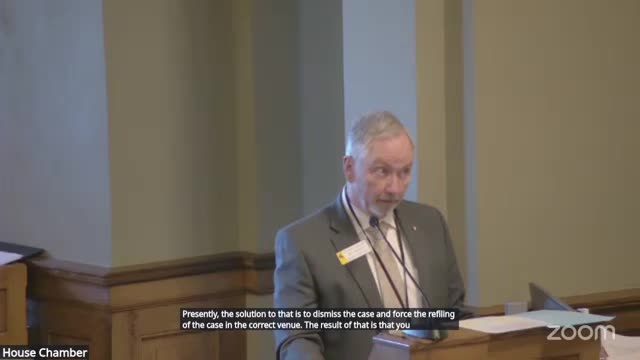House committee backs limits on eminent-domain use for private energy collector systems, sets compensation and consent thresholds
February 22, 2025 | House of Representative, Committees, Legislative, Wyoming
This article was created by AI summarizing key points discussed. AI makes mistakes, so for full details and context, please refer to the video of the full meeting. Please report any errors so we can fix them. Report an error »

The Committee of the Whole advanced Senate File 181 after floor debate about private use of eminent domain to site energy-collection infrastructure associated with commercial electricity generators.
Senate File 181 changes Wyoming’s eminent-domain framework for energy-collector systems associated with commercial generating facilities. The bill specifies compensation standards for condemned property, requires proof of compliance and notice before condemnation, sets conditions for using existing easements to place additional collector infrastructure, and adds contract language requirements addressing liability and reclamation. The bill exempts entities that hold a certificate of public convenience and necessity and excludes energy-collection systems that began serving load or exporting energy from Wyoming before July 1, 2025.
A principal change discussed on the floor reduces the threshold for a supermajority measure from an earlier draft to two-thirds (66%) for certain approvals referenced in the bill’s negotiation framework. Supporters argued the bill balances landowner protections with necessary siting of infrastructure; Representative Banks said the measure places sideboards on eminent-domain use and "is putting sideboards on this practice to protect our private property rights." Opponents described the proposal as insufficient to protect owners; Representative Johnson urged a no vote, comparing eminent-domain expansion to a takeover of private property rights.
The bill contains definitions for "energy collector system" (conductors, towers, substations and related components up to but excluding interconnection facilities) and for "commercial facility generating electricity" (any facility that sells electricity). It prevents a commercial facility’s constructor from using an existing easement agreement to place additional collector systems unless the original easement explicitly contemplates enlargement or the parties renegotiate; otherwise the condemnor must obtain a separate easement. Orders granting easements must include provisions on liability for damages and reclamation obligations.
Lawmakers debated tradeoffs and local impacts. Representative Eklund noted the bill was the result of multiple years' work and described it as an attempt to find a workable balance after contentious local cases; Representative Kelly said the bill did not go far enough but represented progress. After discussion the Committee of the Whole reported the bill as passed.
Ending: The bill advances statutory guardrails on eminent-domain use for private energy infrastructure while leaving unresolved questions about property-rights protections for some landowners; additional floor action will follow.
(For the record: the article paraphrases debate comments from the Committee of the Whole; vote tallies recorded in the transcript are summarized in the actions section.)
Senate File 181 changes Wyoming’s eminent-domain framework for energy-collector systems associated with commercial generating facilities. The bill specifies compensation standards for condemned property, requires proof of compliance and notice before condemnation, sets conditions for using existing easements to place additional collector infrastructure, and adds contract language requirements addressing liability and reclamation. The bill exempts entities that hold a certificate of public convenience and necessity and excludes energy-collection systems that began serving load or exporting energy from Wyoming before July 1, 2025.
A principal change discussed on the floor reduces the threshold for a supermajority measure from an earlier draft to two-thirds (66%) for certain approvals referenced in the bill’s negotiation framework. Supporters argued the bill balances landowner protections with necessary siting of infrastructure; Representative Banks said the measure places sideboards on eminent-domain use and "is putting sideboards on this practice to protect our private property rights." Opponents described the proposal as insufficient to protect owners; Representative Johnson urged a no vote, comparing eminent-domain expansion to a takeover of private property rights.
The bill contains definitions for "energy collector system" (conductors, towers, substations and related components up to but excluding interconnection facilities) and for "commercial facility generating electricity" (any facility that sells electricity). It prevents a commercial facility’s constructor from using an existing easement agreement to place additional collector systems unless the original easement explicitly contemplates enlargement or the parties renegotiate; otherwise the condemnor must obtain a separate easement. Orders granting easements must include provisions on liability for damages and reclamation obligations.
Lawmakers debated tradeoffs and local impacts. Representative Eklund noted the bill was the result of multiple years' work and described it as an attempt to find a workable balance after contentious local cases; Representative Kelly said the bill did not go far enough but represented progress. After discussion the Committee of the Whole reported the bill as passed.
Ending: The bill advances statutory guardrails on eminent-domain use for private energy infrastructure while leaving unresolved questions about property-rights protections for some landowners; additional floor action will follow.
(For the record: the article paraphrases debate comments from the Committee of the Whole; vote tallies recorded in the transcript are summarized in the actions section.)
View full meeting
This article is based on a recent meeting—watch the full video and explore the complete transcript for deeper insights into the discussion.
View full meeting